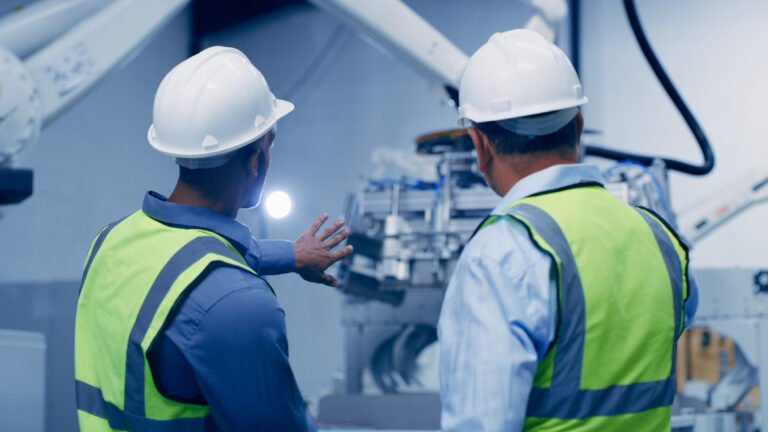For those who head to work each day in a laboratory where flammable materials and other dangerous substances are the norm, the stakes couldn’t be higher. Making a mistake – any mistake – while building or remodeling these environments can have serious consequences. From shutting down a vital product line for an essential drug to a lab explosion, this kind of construction work is some of the riskiest in the industry.
Whether a research lab for a blood center, an adhesive company or a pharmaceutical company producing a vital drug, these construction projects require careful planning, flexibility, precise communication, and an experienced team.
With over 45 years of leadership in the science and tech market, Riley Construction shares five best practices for managing risk to ensure a lab construction project goes smoothly.
Plan, Plan & Plan Again
President Dwight D. Eisenhower once said, “Plans are useless, but planning is indispensable.” This is an apt way to describe the rigorous planning process for constructing in a lab environment. Proper planning should reflect a holistic approach to a variety of complex issues and also include contingencies for potential scenarios. This starts with having the right skilled labor in place to deal with every aspect of the work from mechanical to process piping and HEPA installation. The following are some key aspects of planning to consider as early as possible:
- Order equipment and materials weeks or months ahead
- Delays due to supply chain issues can slow down a project for weeks or months. Ensure that you have the necessary items early and that paperwork is handled properly.
- Evaluate designs for potential issues
- An experienced team will examine drawings and immediately notice if something is off. For example, is there an eyewash station missing from a room? Address issues early to avoid change orders as much as possible.
Because this kind of work involves many moving parts, Riley uses a pull planning system to schedule and track milestones. This improves efficiency and helps maintain flexibility with the inevitable adjustments that are required as the project unfolds.

Understand Your Building Space
Constructing a new laboratory vs. remodeling an existing space requires very different approaches to risk. New facilities are easier to manage since there’s no need to work around existing utility layouts. However, it is essential to consider potential growth so you are planning a lab that could be efficiently expanded at some point.
Managing risk during a lab remodel or expansion can be much more challenging. One issue is being confined by existing layouts and structures that have to be reconfigured. Another factor is conducting work without disrupting the client’s existing production schedule or staff who are currently working in the building.
In either situation, understanding the validation and commissioning process is key as well as ensuring that you have the right individuals working on every aspect of the project.
Maintain Flexibility
Regardless of how well everything is planned, something will inevitably change during the lab construction process. This can happen when the client suddenly needs to start a line back up to finish packaging for a new medicine. This means the team needs to be ready to move at a moment’s notice to shift scheduling and move people around to different projects. Often this kind of flexibility translates into work during the evening or weekends to avoid production disruptions. The ability to manage these complex schedules and quickly respond to the client’s needs is something that Riley’s clients value.
Clear Communications at Every Step
In high-risk construction situations, the consequences of miscommunication are significantly elevated. When working against tight deadlines, clear and concise communication makes it easier to prevent misunderstandings and stay on schedule. That’s why Riley takes a more collaborative approach by involving client owners from the early planning stages through project completion using its proprietary InSTEP approach. Weekly team meetings help target what needs to be updated and detail constraints faced to address them and adapt. Having early and transparent conversations about budget expectations is also crucial so that issues don’t arise later. This is another way that Riley builds trust and relationships with its subcontractors and clients.
Experience to Address Potential Hazards
It’s clear that major risks are inherent in this work. In fact, 45% of lab workers indicate that they have been involved in some kind of lab-related accident.[1] That’s why it’s essential to work with an experienced team that can look around the proverbial corner to predict and manage a risk list of everything that could go wrong. Riley starts with a team review of dos and don’ts based on their specific environment and the materials that they are using. Some key risk areas include:
Explosives – When working in Explosion Proof (XP) facilities with highly volatile solvents, the risk of explosion increases significantly. Riley ensures measures are in place with signage to indicate proper entryways as well as required protection and hot work permits.
Biohazards – To manage the many biohazard risks, from microbiological waste to molds, PPE such as gloves, masks, respirators, or protective clothing are vital. Cleaning services ensure that dust is constantly eliminated to provide a germ-free environment. Wood, for example, could contain bugs, so plastic pallets need to be used in these environments.
At every step of your lab construction, Riley Construction has the experience and knowledge to ensure that the project is well-planned and safely executed, keeping owners involved along the way.
To learn more about Riley Construction’s work in lab facilities, check out Riley Science + Technology or reach out to Riley’s Senior Operations Manager, Jim Moczynski (JimM@rileycon.com).
[1] https://www.sciencedirect.com/science/article/pii/S2093791122000166

